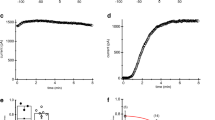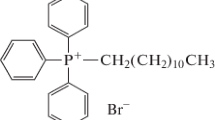Abstract
Although cadmium-induced apoptosis of lymphocytes is one of common features in the immunotoxicity of cadmium, the membrane pathway for intracellular cadmium accumulation is not fully elucidated. To characterize membrane Cd2+ transport of rat thymocytes, the change in intracellular Cd2+ concentration under various conditions was examined by the use of Fluo-3, a fluorescent probe for monitoring the change in intracellular concentration of divalent metal cations. The membrane Cd2+ transport was estimated by the augmentation of Fluo-3 fluorescence induced by bath application of CdCl2. Lowering temperature strongly suppressed the augmentation of Fluo-3 fluorescence by CdCl2, suggesting that the metabolic process can be involved in membrane Cd2+ transport. External acidification (decreasing pH) and membrane depolarization by adding KCl attenuated the augmentation, indicating the requirement of electrochemical driving force for membrane Cd2+ transport into the cells. Bath application of CaCl2 and ZnCl2 equally decreased the augmentation, suggesting their competition with Cd2+ at the membrane transport. The augmentation by CdCl2 was lesser in the cells treated with N-ethylmaleimide inducing chemical depletion of cellular thiols. The result suggests the contribution of sulfhydryl groups to membrane Cd2+ transport. Taken together, it is suggested that the cells possess a temperature-sensitive membrane Cd2+ pathway, driven by electrochemical gradient of Cd2+ and transmembrane potential, with competitive binding site. Based on the characteristics described above, it is unlikely that the membrane Cd2+ transport in rat thymocytes is attributed to a single transport system although it has characteristics that are similar to those of divalent cation transporter 1.







Similar content being viewed by others
References
Au KW, Siu CW, Lau CP, Tse HF, Li RA (2008) Structural and functional determinants in the S5-P region of HCN-encoded pacemaker channels revealed by cysteine-scanning substitutions. Am J Physiol Cell Physiol 294:C136–C144
Borella P, Giardino A (1991) Lead and cadmium at very low doses affect in vitro immune response of human lymphocytes. Environ Res 55:165–177
Bressler JP, Olivi L, Cheong JH, Kim Y, Bannona D (2004) Divalent metal transporter 1 in lead and cadmium transport. Ann NY Acad Sci 1012:142–152
Camacho-Nasi P, Treistman SN (1986) Ethanol effects on voltage-dependent membrane conductances: comparative sensitivity of channel populations in Aplysia neurons. Cell Mol Neurobiol 6:263–279
Chikahisa L, Oyama Y (1992) Tri-n-butyltin increases intracellular Ca2+ in mouse thymocytes: a flow-cytometric study using fluorescent dyes for membrane potential and intracellular Ca2+. Pharmacol Toxicol 71:190–195
Chikahisa L, Oyama Y, Okazaki E, Noda K (1996) Fluorescent estimation of H2O2-induced changes in cell viability and cellular nonprotein thiol level of dissociated rat thymocytes. Jpn J Pharmacol 71:299–305
Chin JH, Goldstein DB (1977) Effects of low concentrations of ethanol on the fluidity of spin-labeled erythrocyte and brain membranes. Mol Pharmacol 13:435–441
Cifone MG, Alesse E, Di-Eugenio R, Napolitano T, Morrone S, Paolini R, Satoni G, Santoni A (1989) In vivo cadmium treatment alters natural killer activity and large granular lymphocyte number in the rat. Immunopharmacol 18:149–156
Cota G, Stefani E (1984) Saturation of calcium channels and surface charge effects in skeletal muscle fibres of the frog. J Physiol 351:135–154
Daum JR, Shephred DM, Noelle RJ (1993) Immunotoxicology of cadmium and mercury on B-lymphocytes. I. Effects on lymphocyte function. Int J Immunopharmacol 15:383–394
Dong S, Shen HM, Ong CN (2001) Cadmium-induced apoptosis and phenotypic changes in mouse thymocytes. Mol Cell Biochem 222:11–20
Edwards C (1982) The selectivity of ion channels in nerve and muscle. Neuroscience 7:1335–1366
El Azzouzi B, Tsangaris GT, Pellegrini O, Manuel Y, Benveniste J, Thomas Y (1994) Cadmium induces apoptosis in a human T cell line. Toxicol 88:127–139
Endo T (2002) Transport of cadmium across the apical membrane of epithelial cell lines. Comp Biochem Physiol C Toxicol Pharmacol 131:223–229
Fontaine J, Dewailly É, Benedetti JL, Pereg D, Ayotte P, Déry S (2008) Re-evaluation of blood mercury, lead and cadmium concentrations in the Inuit population of Nunavik (Québec): a cross-sectional study. Environ Health 7:25 http://www.ehjournal.net/content/7/1/25
Fujimaki H, Ishido M, Nohara K (2000) Induction of apoptosis in mouse thymocytes by cadmium. Toxicol Lett 115:99–105
Garrick MD, Dolan KG, Horbinski C, Ghio AJ, Higgins D, Porubcin M, Moore EG, Hainsworth LN, Umbreit JN, Conrad ME, Feng L, Lis A, Roth JA, Singleton S, Garrick LM (2003) DMT1: a mammalian transporter for multiple metals. Biometals 16:41–54
Garrick MD, Kuo HC, Vargas F, Singleton S, Zhao L, Smith JJ, Paradkar P, Roth JA, Garrick LM (2006) Comparison of mammalian cell lines expressing distinct isoforms of divalent metal transporter 1 in a tetracycline-regulated fashion. Biochem J 398:539–546
Gerson RJ, Shaikh ZA (1984) Differences in the uptake of cadmium and mercury by rat hepatocyte primary cultures. Role of a sulfhydryl carrier. Biochem Pharmacol 33:199–203
Gilbert DL, Ehrenstein G (1969) Effect of divalent cations on potassium conductance of squid axons: determination of surface charge. Biophys J 9:447–963
Girijashanker K, He L, Soleimani M, Reed JM, Li H, Liu Z, Wang B, Dalton TP, Nebert DW (2008) Slc39a14 gene encodes ZIP14, a metal/bicarbonate symporter: similarities to the ZIP8 transporter. Mol Pharmacol 73:1413–1423
Grazia-Cifone M, Alesse E, Procopio A, Paolini R, Di-Eugenio R, Santoni G, Santoni A (1989) Effects of cadmium on lymphocyte activation. Biochem Biophys Acta 1011:25–32
Gukovskaya AS, Zinchenko VP (1985) The effects of ionophore A23187 and concanavalin A on the membrane potential of human peripheral blood lymphocytes and rat thymocytes. Biochim Biophys Acta 815:433–440
Gunshin H, Mackenzie B, Berger UV, Gunshin Y, Romero MF, Boron WF, Nussberger S, Gollan JL, Hediger MA (1997) Cloning and characterization of a mammalian proton-coupled metal-ion transporter. Nature 388:482–488
Haase H, Rink L (2009) The immune system and the impact of zinc during aging. Immun Ageing 6:9
Hagiwara S, Byerly L (1981) Calcium channel. Annu Rev Neurosci 4:69–125
Haugland RP (1996) Fluorescent indicators for Zn2+ and other metals. In: Spence M (ed) Handbook of fluorescent probes and research chemicals, 6th edn. Molecular Probes Inc., Eugene, pp 531–540
Hille B, Woodhull AM, Shapiro BI (1975) Negative surface charge near sodium channels of nerve: divalent ions, monovalent ions, and pH. Philos Trans R Soc Lond B Biol Sci 270:301–318
Himeno S, Yanagiya T, Fujishiro H (2009) The role of zinc transporters in cadmium and manganese transport in mammalian cells. Biochimie 91:1218–1222
Kao JP, Harootunian AT, Tsien RY (1989) Photochemically generated cytosolic calcium pulses and their detection by fluo-3. J Biol Chem 264:8179–8184
Kass RS, Krafte DS (1987) Negative surface charge density near heart calcium channels. Relevance to block by dihydropyridines. J Gen Physiol 89:629–644
Kim MS, Kim BJ, Woo HN, Kim KW, Kim KB, Kim IK, Jung YK (2000) Cadmium induces caspase-mediated cell death: suppression by Bcl-2. Toxicol 145:27–37
Krocova Z, Macela A, Kroca M, Hernychova L (2000) The immunomodulatory effect(s) of lead and cadmium on the cells immune system in vitro. Toxicol In Vitro 14:33–40
Lansman JB, Hess P, Tsien RW (1986) Blockade of current through single calcium channels by Cd2+, Mg2+, and Ca2+. Voltage and concentration dependence of calcium entry into the pore. J Gen Physiol 88:321–347
Liang J, Canary JW (2010) Discrimination between hard metals with soft ligand donor atoms: an on-fluorescence probe for manganese(II). Angew Chem Int Ed 49:7710–7713
Minta A, Kao JP, Tsien RY (1989) Fluorescent indicators for cytosolic calcium based on rhodamine and fluorescein chromophores. J Biol Chem 264:8171–8178
Misra UK, Gawdi G, Akabani G, Pizzo SV (2002) Cadmium-induced DNA synthesis and cell proliferation in macrophages: the role of intracellular calcium and signal transduction mechanisms. Cell Signal 14:327–340
Nachshen DA (1984) Selectivity of the Ca binding site in synaptosome Ca channels. Inhibition of Ca influx by multivalent metal cations. J Gen Physiol 83:941–967
Ohmori H, Yoshii M (1977) Surface potential reflected in both gating and permeation mechanisms of sodium and calcium channels of the tunicate egg cell membrane. J Physiol 267:429–463
Okazaki E, Chikahisa L, Kanemaru K, Oyama Y (1996) Flow cytometric analysis of the H2O2-induced increase in intracellular Ca2+ concentration of rat thymocytes. Jpn J Pharmacol 71:273–280
Olivi L, Sisk J, Bressler J (2001) Involvement of DMT1 in uptake of Cd in MDCK cells: role of protein kinase C. Am J Physiol Cell Physiol 281:C793–C800
Oyama Y, Akaike N, Nishi K (1986) Effects of n-alkanols on the calcium current of intracellularly perfused neurons of Helix aspersa. Brain Res 376:280–284
Oyama Y, Arata T, Chikahisa L, Soeda F, Takahama K (2002) Estimation of increased concentration of intracellular Cd2+ by fluo-3 in rat thymocytes exposed to CdCl2. Environ Toxicol Pharmacol 11:111–118
Pathak N, Khandelwal (2007) Role of oxidative stress and apoptosis in cadmium induced thymic atrophy and splenomegaly in mice. Toxicol Lett 169:95–108
Premkumar LS, Auerbach A (1996) Identification of a high affinity divalent cation binding site near the entrance of the NMDA receptor channel. Neuron 16:869–880
Rega AF, Rothstein A, Weed RI (1967) Erythrocyte membrane sulfhydryl groups and the active transport of cations. J Cell Physiol 70:45–52
Root MJ, MacKinnon R (1993) Identification of an external divalent cation-binding site in the pore of a cGMP-activated channel. Neuron 11:459–466
Schäfer T, Benters J, Beyersmann D (1994) Cadmium uptake and interference with receptor-mediated calcium mobilization in PC12 cells. In: Collery P, Poirier LA, Littlefield NA, Etienne JC (eds) Metal ions in biology and medicine. John Libbey Eurotext, Paris, pp 149–154
Soh H, Park CS (2002) Localization of divalent cation-binding site in the pore of a small conductance Ca2+-activated K+ channel and its role in determining current-voltage relationship. Biophys J 83:2528–2538
Souza V, Bucio L, Gutiérrez-Ruiz MC (1997) Cadmium uptake by a human hepatic cell line (WRL-68 cells). Toxicol 120:215–220
Strotmann R, Harteneck C, Nunnenmacher K, Schultz G, Plant TD (2000) OTRPC4, a nonselective cation channel that confers sensitivity to extracellular osmolarity. Nat Cell Biol 2:695–702
Tsangaris GT, Tzortzatou-Stathopoulou F (1998) Cadmium induces apoptosis differentially on immune system cell lines. Toxicol 128:143–150
Viau M, Collin-Faure V, Richaud P, Ravanat JL, Candéias SM (2007) Cadmium and T cell differentiation: limited impact in vivo but significant toxicity in fetal thymus organ culture. Toxicol Appl Pharmacol 223:257–266
Wilson HA, Chused TM (1985) Lymphocyte membrane potential and Ca2+-sensitive potassium channels described by oxonol dye fluorescence measurements. J Cell Physiol 125:72–81
Acknowledgment
We thank the reviewer for the comments concerning some additional experiments.
Conflict of interest
We have no conflicts of interest on this study. This study was carried out by the institutional expenditure (University of Tokushima).
Author information
Authors and Affiliations
Corresponding author
Rights and permissions
About this article
Cite this article
Kawanai, T., Fujinaga, M., Koizumi, K. et al. Some characteristics of membrane Cd2+ transport in rat thymocytes: an analysis using Fluo-3. Biometals 24, 903–914 (2011). https://doi.org/10.1007/s10534-011-9444-3
Received:
Accepted:
Published:
Issue Date:
DOI: https://doi.org/10.1007/s10534-011-9444-3




